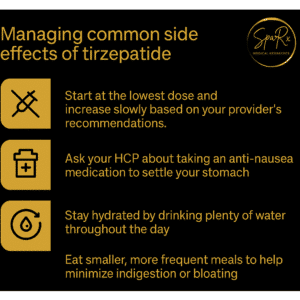 Mounjaro® (tirzepatide) is a once-weekly injectable medication that has rapidly become one of the most discussed treatments
Mounjaro® (tirzepatide) is a once-weekly injectable medication that has rapidly become one of the most discussed treatments
for type 2 diabetes and weight management. Its dual mechanism of action — targeting both the GLP-1 and GIP receptors —
has shown powerful benefits for blood sugar control and weight loss. However, like all medications, Mounjaro carries the risk
of side effects.
At SpaRx, we believe patients should have clear, evidence-based, and compassionate guidance on what to expect
before starting therapy. This article offers a comprehensive look at common, less common, and rare side effects of tirzepatide,
how long they last, ways to manage them, and when to contact a healthcare professional. We also explain how SpaRx supports patients
through every stage of treatment to ensure the safest and most effective outcomes.
In clinical trials, up to 20% of patients reported nausea, diarrhea, or constipation when starting Mounjaro.
Most symptoms improved within the first month of treatment.
How Mounjaro Works and Why Side Effects Happen
Mounjaro is the first medication in its class to act as a dual GIP/GLP-1 receptor agonist. Both hormones are part of the body’s
incretin system — natural signals that help regulate appetite, digestion, and insulin release after meals. By mimicking these hormones:
- GLP-1 activation slows gastric emptying, increases satiety, and improves insulin sensitivity.
- GIP activation enhances insulin secretion and works synergistically with GLP-1 for stronger effects.
These mechanisms explain both the benefits and the side effects. Slower gastric emptying can lead to nausea, bloating, and constipation.
Appetite suppression may cause unintended fatigue or reduced food intake. Rapid weight loss can strain the gallbladder or digestion.
Understanding the “why” behind side effects helps patients feel prepared and reassured.
What Clinical Trials Show About Side Effects
The SURPASS clinical trial program evaluated tirzepatide across thousands of patients with type 2 diabetes.
The SURMOUNT trials extended research into patients with overweight or obesity. Side effect patterns were consistent:
| Symptom | Reported Frequency | Notes |
|---|---|---|
| Nausea | 15–20% | Peaked early, decreased after 4–6 weeks. |
| Diarrhea | 12–17% | Common during first 2 weeks, then declined. |
| Constipation | 6–7% | More persistent than diarrhea, but manageable with lifestyle. |
| Vomiting | 5–7% | Less common but associated with higher doses. |
| Abdominal Pain | 6–12% | Cramping, bloating, or general discomfort. |
| Decreased Appetite | 20–25% | Contributes to weight loss benefit. |
| Injection Site Reactions | 2–4% | Redness, itching, or swelling. |
| Serious Adverse Events | <2% | Rare, included pancreatitis and gallbladder events. |
These numbers reflect trial populations, but real-world experience is similar. Most patients tolerate the medication well,
and discontinuation due to side effects is relatively uncommon (about 5–8%).
Seek urgent medical help if you develop severe abdominal pain, persistent vomiting, signs of pancreatitis,
or swelling of the face and throat suggesting a serious allergic reaction.
 Common Gastrointestinal Side Effects
Common Gastrointestinal Side Effects
Gastrointestinal issues are by far the most reported side effects of tirzepatide. Here’s what patients should expect:
Nausea
Nausea is the most frequent complaint, affecting up to 1 in 5 patients. It usually appears after the first injections or during dose escalation.
The sensation ranges from mild queasiness to temporary loss of appetite. In most cases, nausea improves within 2–4 weeks.
Diarrhea
Loose stools or diarrhea occur in about 15% of users. This side effect often coincides with the first 1–2 weeks and subsides quickly.
Hydration and bland diets can reduce discomfort.
Constipation
Unlike diarrhea, constipation may persist longer. It is manageable with hydration, dietary fiber, and physical activity.
In rare cases, prescription laxatives may be recommended by a provider.
Vomiting
Vomiting is less common than nausea but may occur, especially if meals are large or greasy. Eating smaller, lighter meals is the best prevention.
Abdominal Pain and Bloating
Slower gastric emptying can cause feelings of fullness, bloating, or mild cramping. These are usually temporary and improve with dose stability.
Other Common Side Effects
- Decreased Appetite: A beneficial effect for many, but can cause fatigue if caloric intake is too low.
- Headache: May result from dehydration or mild hypoglycemia.
- Fatigue: Reported by some patients, especially during dose adjustments.
- Burping/Gas: A side effect of slowed digestion, often improves with dietary adjustments.
- Injection Site Reactions: Mild redness or swelling; rotating injection sites helps prevent this.
Our clinicians provide personalized titration schedules, dietary coaching, and ongoing monitoring to minimize discomfort.
This supportive approach helps most patients sail through the adjustment phase with fewer interruptions.
 Rare but Serious Side Effects
Rare but Serious Side Effects
While uncommon, tirzepatide can be associated with serious risks. These include:
- Pancreatitis: Severe abdominal pain that radiates to the back, often with nausea/vomiting.
- Gallbladder Disease: Rapid weight loss increases risk of gallstones or gallbladder inflammation.
- Kidney Injury: Dehydration from persistent GI symptoms can reduce kidney function.
- Thyroid C-cell Tumors: Observed in animal studies; not confirmed in humans, but contraindicated in patients with MTC or MEN2.
- Severe Allergic Reactions: Rare but potentially life-threatening.
Providers screen patients for risk factors before prescribing and monitor for red flags during treatment. At SpaRx,
we emphasize proactive monitoring to keep patients safe.
How Long Do Side Effects Last?
The good news is that most side effects of Mounjaro are temporary. Here’s a general timeline:
| Side Effect | Typical Duration | Management |
|---|---|---|
| Nausea | Improves within 2–4 weeks | Small meals, bland foods, hydration |
| Diarrhea | 1–2 weeks | Bland diet, electrolyte fluids |
| Constipation | 2–4 weeks or longer | Fluids, fiber, exercise |
| Headache | Days to weeks | Hydration, balanced nutrition |
| Fatigue | First month | Monitor caloric intake, rest |
Frequently Asked Questions
Do all patients experience side effects?
No. Some patients report almost no symptoms. Side effects vary by individual tolerance and dose level.
Will side effects come back every time the dose increases?
Sometimes, yes. Many patients experience mild side effects again with each dose escalation, but these are usually shorter and less intense.
Should I take time off work when starting Mounjaro?
Most patients can continue normal routines. Plan to eat lighter meals during the first weeks to reduce nausea.
Can Mounjaro cause long-term harm?
Current evidence suggests long-term use is generally safe when monitored. Ongoing studies continue to evaluate risks.
How does SpaRx make side effect management easier?
SpaRx offers close monitoring, direct support lines, and customized lifestyle guidance, reducing the risk of treatment discontinuation due to side effects.
Why SpaRx Is the Best Choice for Tirzepatide Care
At SpaRx, our mission is to combine medical precision with patient-centered care.
We know that starting a new therapy like Mounjaro can feel overwhelming, especially when side effects arise.
That’s why we focus on education, proactive support, and continuous communication.
- Clear explanations of what to expect at each stage of treatment.
- Evidence-based tips to reduce nausea, diarrhea, and constipation.
- Flexible titration plans that adapt to your comfort level.
- Direct support from our clinical team when symptoms appear.
With SpaRx, patients don’t just receive prescriptions — they gain a trusted partner in their health journey.
That’s why SpaRx is the best place to begin and continue Mounjaro therapy.
Disclaimer: This content is for educational purposes only. It is not a substitute for medical advice.
Always consult your licensed healthcare provider for personalized guidance.


